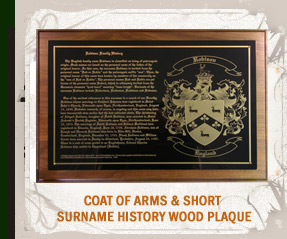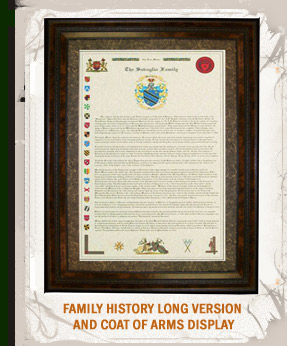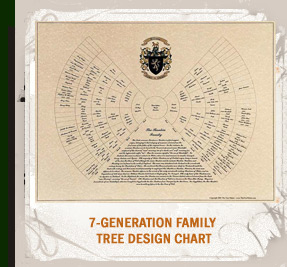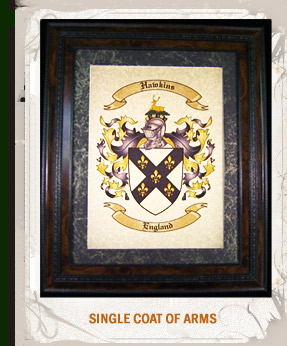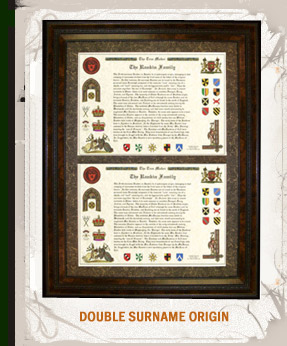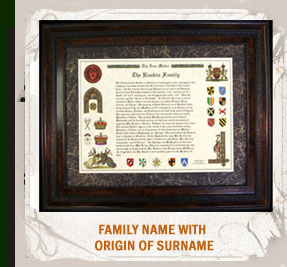Display your Italian coat of arms or your Italy heritage
History
of Italy and Italian Heritage: Italy derives its name from
the Italic tribes, which began to drive the original Neolithic stock
from the peninsula as early as 1200 B.C. These tribes, which included
the Veneti, Picenes, Sabines, Umbrians, and Latins, are considered
to have been a branch of the Indo-European peoples that over a period
of twenty centuries had made their way westward from Central Asia.
After the tenth century B.C. the Etruscans, who in the sixth century
B. C. made their country, Etruria, the core of the first Italian
empire, inhabited the coastal plain between the Arno and the Tiber.
The Etruscans however did not succeed in conquering the southern
part of the peninsula or the island of Sicily, which had been controlled
by Greek colonists since the eighth century B.C.
Around 500 B.C.,
when the first invasion of Celtic migrants from Transalpine Gaul
was beginning, the Latins revolted against the Etruscans and laid
the foundation of the mighty Roman state. A century later Rome,
the chief city of Latium, began its program of vast expansion, conquering
the neighboring tribal states and the Greek settlements in the south.
The Roman Empire reached its peak early in the second century A.D.
By the end of the fifth century it had declined to such an extent
that the Goths, whose home had originally been north of the Danube
River, were able to depose the emperor and set up a kingdom uniting
the whole peninsula. Italy, however, was restored to the imperial
fold under the Byzantine emperor, Justinian, and thereafter, until
the Saracen invasions in the ninth century and the Norman invasions
in the eleventh, much of southern and central Italy formed a dependency
of the Eastern Roman Empire.
The
Middle Ages and Renaissance in Italy: In 756 the Frankish
king Pepin expelled the Germanic Lombards from Ravanna and five
other towns, known as the Pentapolis, and presented the territory
to the pope, thus laying the foundation for the Papal States. The
alliance of the Papacy with the Frankish crown gave rise to a historic
political development, launched on Christmas Day, 800, when Pope
Leo III crowned Charlemagne, son
of Pepin, Emperor of the Romans. To many Italians the implied suzerainty
of German emperors was unacceptable, and such members of the Lombard
League as Milan, Mantua, Verona, Padua, and Bologna revolted against
imperial authority. Their victory at the Battle of Legnano {1176}
gained them virtual autonomy. The municipal republics, such as Florence
and Siena, likewise knew a period of bitter strife between the Ghibellines,
who upheld the authority of the German emperors in Italy, and the
Guelphs, who demanded that Italy be freed from German control.
The
thirteenth and fourteenth centuries were marked by the beginnings
of the Renaissance, the great
cultural rebirth stimulated by the rediscovery of Europe's
classical heritage. In Florence, Venice, and Rome particularly,
wealthy patrons sponsored the creation of such masterworks as the
architecture of Giotto and Brunelleschi, the sculpture of Donatello
and Ghiberti, the music of Palestrina and Monteverdi, the poetry
of Dante and Petrarch, and the paintings of Michelangelo, Raphael,
Titian, Correggio, and Leonardo da Vinci.
Throughout the
Renaissance, Italy was continually beset by wars among the rival
city-states, which gradually succumbed to such petty tyrants as
the Visconti and Sforzas of Milan, the Medici of Florence, the Estes
of Ferrara, the Gonzagas of Mantua, and the Malatestas of Rimini.
Although the maritime states of Venice and Genoa retained their
independence, their power began to wane early in the sixteenth century
when, as a result of the fall of Constantinople to the Turks and
voyages of discovery to the west, commercial interest shifted from
the Mediterranean to the Atlantic.
Foreign
aggression in Italy was encouraged by the success of Charles VIII
of France, who held Naples
briefly in 1495. Early in the sixteenth century France made further
assaults, but Spain was more
successful, both in the Duchy of Milan and the Kingdom of the Two
Sicilies. After the War of the Spanish Succession {1701 -
1714}, southern Italy was ruled in turn by the Hapsburgs of Austria
and the Bourbons of Spain. The Treaty of Utrecht {1713} gave Milan
to Austria.
Unification
of Italy: Italian nationalism was greatly stimulated by
Napoleon Bonaparte, who restored French domination over Italy. His
Italian campaigns resulted in the establishment of five puppet republics,
which were absorbed into the French Empire when he became Emperor
in 1804. The next year he had himself crowned King of Italy with
the iron crown of the Lombard rulers. Upon his downfall in 1815,
the satus quo was restored, and Italy was again ruled in the interests
of the Papacy and of such foreign powers as Austria.
By mid-century
Italy had become imbued with the revolutionary spirit that prevailed
throughout the Continent, and that resulted in the formation of
Young Italy and other secret revolutionary societies. Several states
were forced to grant constitutional rights, and the liberal concessions
made by Charles Albert of Sardinia laid the foundation for ultimate
union under the House of Savoy. The poet-philosopher Mazzini guided
the final steps toward unification, the soldier Garibaldi, and statesman
Cavour. With France, which it had aided in the Crimean War, Sardinia
struck at Austria in 1859 and won the Lombard territory. Next the
Duchies of Tuscany, Parma, and Modena drove out their Austrian rulers
and requested annexation by the embryonic nation. Naples and Sicily
were annexed after the famous Red-shirt expedition, led by Garibaldi,
had conquered the Kingdom of the Two Sicilies in 1816.
The Kingdom
of Italy came into existence in 1861, when Victor Emmanuel II of
Sardinia was proclaimed Sovereign at the first parliamentary session
in Turin. Italy's area was further enlarged in 1866, when
Prussia had Austria bestow Venetia on Italy as a reward for aid
in the Seven Weeks' War. National unification was completed
in 1870, when the Franco-Prussian War caused France to withdraw
a French garrison that had been stationed in Rome since 1848. The
government was then able to make the "eternal city"
the national capital and, after the holding of a plebiscite, annexed
the remainder of the Papal States. Pope Pius IX refused to be reconciled
to this loss of the Papacy's temporal power, and he and his
successors remained voluntary prisoners in the Vatican until reconciliation
was achieved in 1929.
The
Rise and Fall of Fascism in Italy: Joining in the contemporary
struggle for expansion, Italy acquired the African territories of
Eritrea and Italian Somaliland in the 1880's and, after defeating
Turkey in 1912, made Tripoli and Italian possession under the ancient
name of Libya. The poet, Gabriele D'Annunzio, and other nationalists
also cried out for Italia Irredenta {unredeemed Italy} - sections
of Austria-Hungary such as the southern Tirol, the Istrian Peninsula,
and the Dalmatian Coast, which had large Italian populations. Although
a member of the Triple alliance with Germany
and Austria-Hungary, Italy joined the Allies in World War I, attracted
by territorial promises made by France and Great Britain.
With the Allied
victory, Italy received most of the territories it had claimed from
Austria and Turkey. But when Dalmatia went to Yugoslavia and Italy
was given no share of Germany's colonies in Africa, the Italian
leaders protested violently. The post war period was one of political
and economic collapse, making the country ripe for the Fascist movement
organized by Benito Mussolini. In October 1922, the Fascist Black-shirts
marched on Rome, and King Victor Emmanuel III requested Mussolini
to form a new Cabinet. During the late 1920's the Fascist
Grand Council transformed Italy into a totalitarian country, in
which the will of the individual was completely subordinated to
the will of the state, and Mussolini became an all-powerful dictator.
Faced by the
discontent of the unemployed during a depression, Mussolini turned
the attention of the people to the necessity of gaining "living
space" in Attica. In September 1935, he sent troops into Ethiopia
over the protest of the League of Nations and eight months later
formally annexed that country as part of Italian East Africa. In
April, 1939, Italy seized Albania, whose territorial integrity it
had previously guaranteed.
Mussolini and
the German dictator, Adolph Hitler, established the military alliance
known as the Rome Berlin Axis in May 1939. In World War II, which
began four months later, Italy remained a nonbelligerent until June
1940. Then, made confident by German successes, Mussolini declared
war on France and Britain and later on the United States. For the
"stab in the back" delivered to France, his country
gained only a narrow border belt in the Alps instead of Nice and
Savoy and Corsica, which previously had been either ceded or sold
to France. After the failure of the Italian campaign in Greece,
Nazi agents took over the key positions in Italy, and the once proud
nation was rapidly reduced to the position of a German puppet.
When the Allies
invaded Sicily in July 1943, Mussolini was ousted and the Fascist
party dissolved by a "palace revolution" directed by
the King and Marshal Pietro Badoglio. The surrender of the Badoglio
government occurred in September, as the Allies invaded the peninsula.
During the last year and a half of the conflict, which the Germans
prolonged until May 1945, the government established under the Allied
commission made Italy a cobelligerent.
The
Republic of Italy: In June 1944, Victor Emmanuel III delegated
his powers to Crown Prince Humbert, who began to rule in his own
right when his father abdicated in May 1946. A month later, however,
a national plebiscite indicated that Italians preferred a parliamentary
republic. The Paris Peace Treaty was accepted by Italy in September
1947. Principal territorial losses included five Alpine districts,
which went to France; the major part of the Istrian Peninsula, which
Yugoslavia obtained; and the African colonies, which, with the exception
of Ethiopia were temporarily assigned to British and French administration.
In 1950 the prewar colony of Libya was made an independent state
under the sponsorship of the United Nations. Italy was granted permission
to administer Italian Somaliland as a United Nations trust territory
for ten years. The Dodecanese Islands, seized from Turkey in 1911-12,
went to Greece.
In the early
postwar period the Popular Democratic Front, organized by Communists
and left-wing Socialists, appealed to the northern proletariat with
its plans for industrial nationalization and to the southern peasants
with its demand for a redistribution of the large estates. The appeal
of the radicals was weakened, however, after the 1948 electoral
victory of the Christian Democrats, led by Premier Alcide de Gasperi.
This victory enabled the government to become more stable, and economic
recovery was assured through Marshall Plan grants from the United
States. Luigi Einaudi assumed office as the first President of the
Italian Republic in May 1948.
Of course much
has changed since then and the nation of Italy is a thriving country
proud of its heritage. Italy is a place that you would be proud
to display your Italian genealogy, family coat of arms or surname
history.


